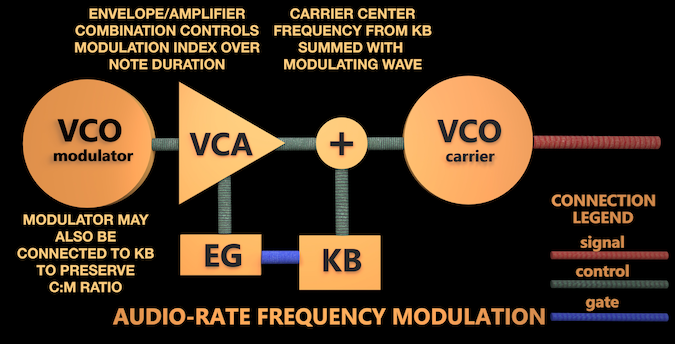Chapter Four: Synthesis

8. Principles of Audio-rate FM Synthesis
This section explains the phenomenon of audio-rate frequency modulation (FM), which was explored and used compositionally by John Chowning, former director of Stanford University's CCRMA studios, beginning around 1970. His discoveries eventually lead to the design and release of the Yamaha DX-7 family of instruments, one of the most successful synthesizers of all time and a bonanza for Stanford, which held the patent rights. The technique, when employed digitally, was extremely "inexpensive" computationally and allowed for the creation of complexly evolving timbres, which Chowning noted mimicked real-world sound more accurately than simple filtering. In fact, the DX-7 had no filters at all and relied 100% on control of the FM timbres via its many algorithms.
As discussed in the subaudio-rate vibrato section, if the output of an oscillator is applied to control the frequency of another oscillator, frequency modulation (FM) will result. The oscillator providing the control source is referred to as the modulator, the oscillator providing the signal is referred to as the carrier. If the modulating oscillator is tuned below audio-rate (or approximately 20 Hz), sub-audio frequency modulation or vibrato will result. As the modulating waveform rises (increases in amplitude), so too will the frequency of the carrier; as it falls, so too will the frequency of the carrier. The rate of the vibrato is determined by the modulator's frequency, the depth of the vibrato (or how far above and below its center frequency the carrier will be pushed) is determined by the modulator's amplitude, and the shape of the vibrato is determined by the modulator's waveform. It is important at the outset of the discussion to realize that the modulator is not part of the signal path--it is never heard directly, only its effect on the carrier frequency.
A schematic of a basic frequency modulation patch using the same symbols from Section 6 is illustrated below:

Audio-rate frequency modulation
When the rate of the modulating oscillator is tuned to an audio rate, above 20 Hz, very interesting things happen to the sound. Additional frequencies called sidebands appear symmetrically around the carrier frequency. Those above the carrier frequency are called upper sidebands and below are called lower sidebands. To create these sidebands, some of the energy of the carrier frequency is being 'stolen' to energize these additional frequencies.
'Chowning' FM
Both the exact frequencies and the relative strength of the sidebands are predictable using digital technology, since all parameters can be precisely controlled. The bulk of our discussion will deal with classic or Chowning FM, named after its greatest proponent. Simple Chowning FM uses the most basic sine wave, which produces no other frequencies apart from its fundamental, as both the carrier and modulating waveform. Indeed, one of the beauties of Chowning FM is its ability to do so much from two very simple waves. The other qualification of Chowning FM is that the modulation be linear, whereby the carrier is pushed an equal number of cycles per second above and below its center frequency. Exponential FM, where the carrier is pushed up and down an equal musical interval (therefore more Hz up than down) drifts upwards in its pitch axis as the modulation depth is increased . Linear FM allows the strength of modulation to be increased without the perceived center frequency rising.